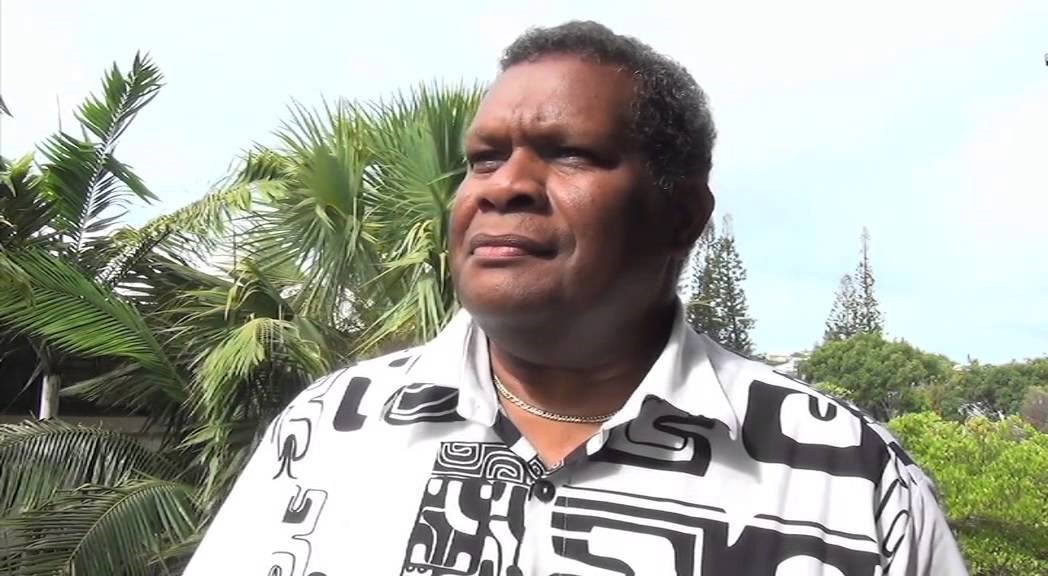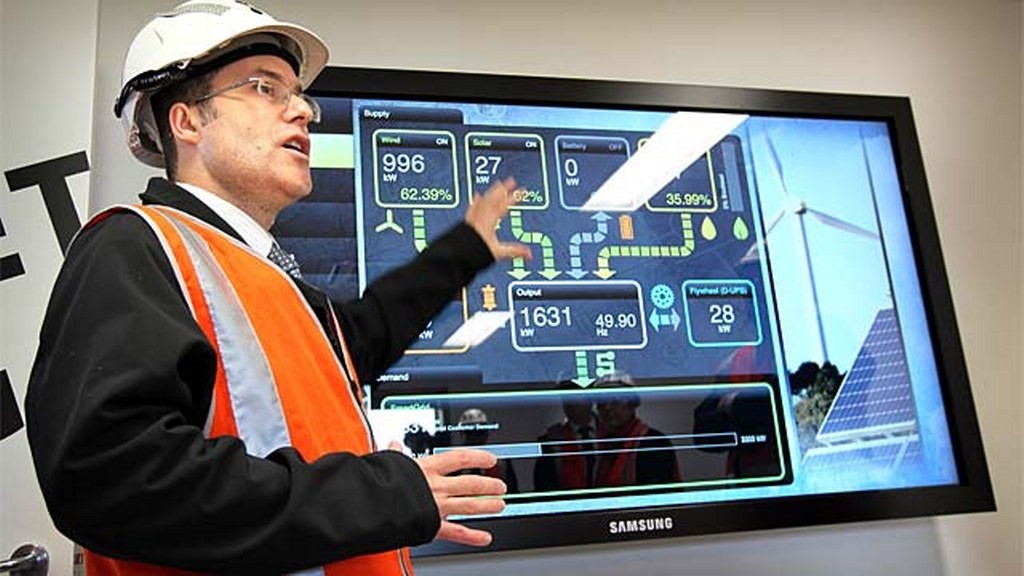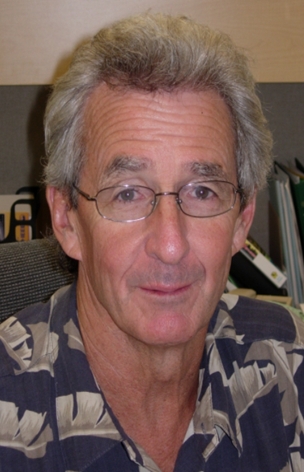Richard Rocheleau (PhD, Chemical Engineering, University of DE), has over 35 years of experience in renewable energy, with an emphasis in the areas of photovoltaics, hydrogen fuel cells, and energy systems. Dr. Rocheleau joined the faculty of the Hawaii Natural Energy Institute at the University of Hawaii in 1988 and was appointed Director in 2000. Under his direction, the Institute is leading the development of public‐private partnerships focused on the development, testing and integration of alternative energy technologies into the electrical grid. HNEI has major funding from the US Department of Energy and the Office of Naval Research. Dr. Rocheleau was also successful in positioning the Institute to receive a portion of the ‘barrel tax’, established by the Hawaii State Legislature supporting studies for integration of renewable energy technologies into the grid intended to assist the state to meet its aggressive renewable energy portfolio goals.
Hawaii’s 100% Renewable Energy Goals: Status and Issues
Although the Hawaiian Islands are blessed with an abundance of renewable energy sources including excellent solar and wind resources, and have the nation’s most aggressive renewable energy standards, the state still rely heavily on fossil fuels for electricity generation. With isolated (unconnected) island grids and sparse systems on some islands, integration of the intermittent renewable generation systems has been challenging. The Hawaii Natural Energy Institute (HNEI) at the University of Hawaii has initiated an integrated effort involving modeling, testing, and demonstration to identify and validate pathways to higher renewable integration. In this talk, I will discuss the analysis being used to identify strategic paths forward and will describe several projects currently underway including the Maui Smart Grid Demonstration Project, the Smart Grid Inverter Project and several grid-scale battery energy storage projects.
 DR YUICHI KADO
DR YUICHI KADO
In July 2010, he joined the Department of Electronics, Kyoto Institute of Technology, Kyoto, Japan. His current research interests include multi-port power routers to build energy interchanging systems. He has been the recipient of awards including the 2009 Nikkei BP Technology Award, the 2009 Radio wave Achievement Award presented by the ARIB, and the 2009 Telecom System Technology Award presented by the Telecommunications Advancement Foundation. He is a board member of NPERC-J (http://www.nperc-j.or.jp) and a member of IEEE.
BEYOND JUMP SMART MAUI
The JUMP Smart Maui project implemented from 2011 to 2016, which Hitachi led as the key technology provider together with several industrial stakeholders in Japan and Hawaii, was engaged in the development and demonstration of Vehicle to Grid integration in Maui.
The objective of the project is to install and operate infrastructure to help the island transition to clean energy to transportation and also to help electrical grid introduce more renewables by utilizing distributed energy resources especially electric vehicles (EVs).
The project integrates 13 stations / 44 ports of DCFC charging stations and also 200 home chargers for V1G and 80 home chargers for V2G. The number of EVs in Maui was around 80 on starting the project in 2011. At the end of the project, the number of EVs went up around 780 in 2016. The number of DCFCs is still more than 300 users in 2018.
Regarding the contents of technology demonstration, V1G demonstration includes tests of home charging behavior in peak period of grid demands and managed charging based on utility’s and the participants’ needs with 200 houses participants. V2G demonstration includes tests of managed charging and discharging with 80 Hitachi bi-directional chargers.
With the depth and breadth of experiences above, after this demonstration in 2016, Hitachi and our partners are expanding V2X capabilities, which includes assessment demonstration of estimated capacity of aggregated EV batteries with bi-directional chargers and frequency control with Hawaiian utility company.
As the result of experiences in Maui demonstration, Hitachi has established technology confidence in V1G and V2G functions. Key device, EV power conditioning system, is also developed with our partner “IKS” and upgraded as “Hybrid PCS” with bi-directional charging functions integrating EV, PV and battery with CE and UL certifications. Hybrid PCS has been used by our customers in Japan U.S.A. and Europe since 2018.
These movement tightly related to DC (Direct Current) technologies and telecommunication technology expansions, to show the future direction of DC technology, Hitachi also introduces new partner in this area. Dr. Yuichi Kado will introduce the latest tecknology, Triple-Active-Bridge Converter and the demonstration utilizing those converters experimented on distributed network.
We believe that these various potentialities of EV are getting bigger very quickly and these unique aspects will be commonly used as a part of distributed energy resources and lead a key device of compact city in the future.
 MR FUMITOSHI EMURA
MR FUMITOSHI EMURA
Social Innovation Business Division, IoT Business Division
Division Manager
Mr Fumitoshi Emura has been mainly in charge of overseas project promotion, new business developments as well as business alliances. He was dedicated to smartgrid demonstration project on Maui Island in Hawaii as the the president of Hitachi Advanced Clean Energy Corporation in Hawaii from 2014 to 2017.
BEYOND JUMP SMART MAUI
The JUMP Smart Maui project implemented from 2011 to 2016, which Hitachi led as the key technology provider together with several industrial stakeholders in Japan and Hawaii, was engaged in the development and demonstration of Vehicle to Grid integration in Maui.
The objective of the project is to install and operate infrastructure to help the island transition to clean energy to transportation and also to help electrical grid introduce more renewables by utilizing distributed energy resources especially electric vehicles (EVs).
The project integrates 13 stations / 44 ports of DCFC charging stations and also 200 home chargers for V1G and 80 home chargers for V2G. The number of EVs in Maui was around 80 on starting the project in 2011. At the end of the project, the number of EVs went up around 780 in 2016. The number of DCFCs is still more than 300 users in 2018.
Regarding the contents of technology demonstration, V1G demonstration includes tests of home charging behavior in peak period of grid demands and managed charging based on utility’s and the participants’ needs with 200 houses participants. V2G demonstration includes tests of managed charging and discharging with 80 Hitachi bi-directional chargers.
With the depth and breadth of experiences above, after this demonstration in 2016, Hitachi and our partners are expanding V2X capabilities, which includes assessment demonstration of estimated capacity of aggregated EV batteries with bi-directional chargers and frequency control with Hawaiian utility company.
As the result of experiences in Maui demonstration, Hitachi has established technology confidence in V1G and V2G functions. Key device, EV power conditioning system, is also developed with our partner “IKS” and upgraded as “Hybrid PCS” with bi-directional charging functions integrating EV, PV and battery with CE and UL certifications. Hybrid PCS has been used by our customers in Japan U.S.A. and Europe since 2018.
These movement tightly related to DC (Direct Current) technologies and telecommunication technology expansions, to show the future direction of DC technology, Hitachi also introduces new partner in this area. Dr. Yuichi Kado will introduce the latest tecknology, Triple-Active-Bridge Converter and the demonstration utilizing those converters experimented on distributed network.
We believe that these various potentialities of EV are getting bigger very quickly and these unique aspects will be commonly used as a part of distributed energy resources and lead a key device of compact city in the future.
 ANDREW DAKA
ANDREW DAKA
EXECUTIVE DIRECTOR, PACIFIC POWER ASSOCIATION
The PPA’s objective is to improve the quality of power in the region through a cooperative effort among the utilities, private sector and regional aid donors. The PPA provides direct links between the private sector and member utilities to improve private sector services and thus make their presence in the region more productive.
Renewable Ready Pacific
The PPA is an inter-governmental agency and member of the Council of Regional Organisations in the Pacific (CROP) to promote the direct cooperation of the Pacific island power utilities in technical training, exchange of information, sharing of senior management and engineering expertise and other activities of benefit to the members.
The PPA’s objective is to improve the quality of power in the region through a cooperative effort among the utilities, private sector and regional aid donors. The PPA’s members pool their resources and expertise for their common benefit, gain international representation and improve access to international power sector assistance programmes.
 SIMON GAMBLE
SIMON GAMBLE
CHIEF OPERATING OFFICER, ENERNET GLOBAL
Simon is chief operating office and Asia pacific managing director for Enernet Global. Simon was formely with Hydro Tasmania including roles as Manager, Hybrid Off-Grid Solutions and Project Director for the King island Renewable Energy Integration Project (KIREIP). Simon was awarded a 2010 Fulbright Academic Exchange Scholarship, having previously been acknowledged under the Australia Korea Foundation: Next Generation Leaders Program.
HYBRID MICROGRID DEPLOYMENT IN THE COMMERCIAL AND INDUSTRIAL SECTOR
Enernet Global implements microgrids in the traditional off-grid sectors, such as remote communities and the mining sector. In recent months the deployment of microgrid technology to grid connected clients in the commercial and industrial sectors is becoming more prevalent, as behind the meter solutions are offering cost effective solutions to traditional retailed energy services.
Commercial microgrids also offer enhanced energy services with increased levels of energy security and reliability and the prospect for seamless islanding where grids offer less than acceptable reliability.
Enernet will outline how the economics of solar PV and energy storage, and the integration of these systems into on-site load and demand management is driving a whole new class of renewable microgrids.
 RAY MASSIE
RAY MASSIE
MANAGER OFF-GRID HYBRID SOLUTIONS, HYDRO TASMANIA
Hydro Tasmania are Australia’s largest renewable generator, and have a comprehensive track record in assisting remote island communities switch to reliable clean energy systems.
The Flinders Island development involves integration of wind and solar generation with the existing diesel power station and the installation of enabling technology, such as a control system, flywheel, dynamic resistor and battery energy storage. Hydro Tasmania has worked with Tasmanian manufacturers to develop a series of modular units to house and ship the enabling technologies essential to the energy solution.
Equipment was fabricated and tested off-site, ensuring a speedy rollout at the final location, reducing the risk, cost and duration of construction. The modular units provide a lower cost and scalable solution that will allow easy and rapid transport and installation for renewable energy projects and can also serve temporary generation, such as in disaster relief or in the mining industry.
Since commissioning in late 2016 the Flinders Island hybrid energy hub has run 100% renewable for half of the time.
 JAMES HAMILTON
JAMES HAMILTON
UNIVERSITY OF TASMANIA
AUSTRALIAN LOW LOAD & VARIABLE SPEED TECHNOLOGY CASE STUDIES
Australian utilities are at the fore of innovative diesel based enablers, able to substantially reduce the cost and complexity of high penetration renewable integration. The technology progression can be traced back to 2003, with low load diesel units commissioned within the Denham wind diesel system. More recently the application has been validated across a range of utility application including Rottnest Island and King Isand. King Island has set a number of records including a sustained and stable diesel off capability, in addition to hosting Australia’s largest battery energy storage system. This presentation also covers the development of variable speed diesel platforms, a natural extension to low load application, providing for efficiency improvements of 40% at low load. The technology provides a pathway to renewable integration without a requirement for battery storage, significantly reducing the cost and compexity of system hybridisation.
 SIMON FRANKLIN
SIMON FRANKLIN
MANAGING DIRECTOR AT IT POWER
Simon has over 10 years’ experience in the Australian energy sector. He has worked on large and commercial scale grid-connected photovoltaic PV systems, hybrid off-grid power stations, financial modelling, energy efficiency audits and PV system performance modelling.Simon is an experienced project manager and has a strong background in renewable energy, with a Bachelor of Engineering (1st Class Honours) and Bachelor of Information Technology from the Australian National University.Before joining ITP Renewables, Simon was an Electrical Engineer with Connell Wagner (Aurecon) where he undertook project management, electrical design and risk management work on rail infrastructure and defence projects. Simon has also worked with the Cooperative Research Centre for Greenhouse Gas Technologies, investigating the feasibility of carbon capture and storage technologies.
Simon is a former Director of the Australian Solar Council (ASC), previously the Australian Solar Energy Society (AuSES).
 GOOI HOAY BENG
GOOI HOAY BENG
Dr. Gooi is a Senior Member of IEEE and a registered professional engineer in the Commonwealth of Pennsylvania, USA and Singapore. He is a member of 2018/19 Energy Technical Committee, Institution of Engineers, Singapore and Chairman of Sub-Committee for Fundamentals of Engineering Examination (Electrical), Professional Engineers Board Singapore. He taught Energy Management System courses for dispatchers and managers at Power System Control Centre in Singapore, Indonesia and Malaysia. He has published over 250 technical papers.
For more information about the speaker, please visit http://www.ntu.edu.sg/home/ehbgooi/.
HIERARCHICAL TRANSACTIVE ENERGY MANAGEMENT SYSTEM FOR ENHANCED COMMUNITY MARKET PARTICIPATION
Unlike existing Energy Management System (EMS) which usually runs from a centralized server system at Power System Control Centre and operates large generating units and a transmission system via dedicated communication channels, this project aims to develop a low-cost, scalable, hierarchical transactive energy management system for use by load and supply aggregators of distribution systems. The loads and distributed energy resources are small in capacity but large in quantity. The proposed system considers three sets of inputs: supply side (e.g. intermittent PV system, bi-directional storage battery as supply, etc), demand side (e.g. variable controllable loads, storage battery as load, etc) and price fluctuations in real-time energy and reserve markets. A two-stage optimization technique is proposed for managing different types of battery energy storage systems. A model predictive control (MPC)-based controller scheme that is capable of coordinating hybrid energy storage systems and intermittent energy sources is validated via control-hardware-in-the-loop (CHIL) test setup in the lab. A decision support tool that can facilitate participation of loads in a demand response market is designed and proposed for use by load and supply aggregators.
For more information about Nanyang Technological University, please visit http://www.ntu.edu.sg.
PAUL PAUZE
CEO & PRESIDENT AT INNOVUS POWER INC
Paul Pauze is the Vice President of Business Development and Sales for Innovus Power Inc., a North American company who has developed the first microgrid control system with commercial, primary power variable speed generator (VSG).
Prior to joining Innovus in 2016, Paul was the founder and President of SunRise Power Corp. a leading Ontario solar manufacturer and engineering firm from 2009-2015 specializing in commercial rooftop solar PV systems. SunRise was Ontario’s first-string inverter manufacturer and delivered the provinces first commercial rooftop racking systems.
Before joining the renewable industry, Paul spent many years in manufacturing with General Electric in Peterborough Ontario, in a number of rolls from Engineering Manager, Lean Leader to Plant Manager.
Paul has been a professional engineer for 20+ years, and a member of the Ontario Society of Professional Engineers holding a Bachelor of Science in Electro-Mechanical Engineering from Queens University where Paul started his career in renewables as Electrical Manager of the Solar Vehicle program leading the team to a top 5 at SunRayce 95.
VARIABLE SPEED DIESEL AND NATURAL GAS GENERATION FOR 100% RENEWABLES INTEGRATION
Today’s sophisticated microgrids are challenged by operating with 125-year-old synchronous generation technology. Complex systems, controls, and storage are required to maintain grid stability when integrating high penetration renewables. Using power electronics to enable Variable Speed Generation (VSG) optimizes efficiency by allowing the generator’s engine to operate at optimal speeds for any load and maintains microgrid stability at any renewable penetration by producing power through a back to back converter platform.
This presentation discusses technology advances that eliminate the need for storage to provide grid stability for high penetration renewables, therefore significantly lowering the levelized cost of energy.
We will discuss the results of the Waterloo Institute for Sustainable Energy report, “Feasibility of Variable Speed Generators for Canadian Arctic Communities”. The report demonstrates how the use of converter-based generation significantly lowers emissions, fuel consumption and provides the lowest LCOE for remote northern community renewable integration.
We will also review the results from a recent installation of a 590kW VSG installation in the community of Aklavik Northwest Territories Canada.
- Understand the benefits of decoupling Engine speed from frequency
- How converter-based generation enables high penetration renewables
- Understand the potential for high transient response and sub 10 seconds for natural gas generators
- Understand how variable speed generation reduces engine damage and maintenance costs –
